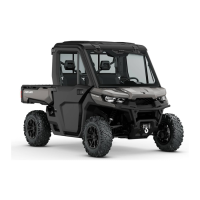SAFE OPERATION - RESPONSIBILITIES
Carrying Passengers
Only carry a maximum of two passen-
gers. The passengers must be prop-
erly seated in the cockpit.
The passengers must be tall enough
to always be properly seated: back
against the backrest with seat belt fas-
tened, holding the handhold, and feet
firmly planted - for the RH passenger,
with right foot on the footrest and the
left foot on the vehicle floor and for
the central passenger, with both feet
firmly planted on the floor.
Never carry passengers who hav e
used drugs or alcohol, or are tired or
ill. T he se slow reaction time and im-
pair judgment.
Instruct the passengers to read the ve-
hicle’s safety labels.
Never carry passengers if you judge
their ability o r judg ement insufficient
to concentrate on the terrain condi-
tions and adapt accordingly. More
specifically for side-by -sid e ve hicles,
the passenger must also pay constant
attention to the terrain ahead and be
able to brace for bumps.
Riding Carefully
– This vehicle handles differently
from other vehicles. A collision or
rollover can occur quickly, during
abrupt maneuvers such as doing
sharp turns, acceleration or decel-
eration and driving on hills or over
obstacles, if you fail to take proper
precautions.
– Never operate at excessive speeds.
Always go at a speed that is proper
for the te rrain , visibility, and op
erat-
ing conditions, and your experience.
– Never attempt jump s, side slides,
donuts or any other stunts.
– Never attempt rapid acceleration
or deceleration when perfor
ming a
sharp turn. This may result in a roll
over.
– Never attempt skidding or sliding .
If vehicle starts to skid or slide,
counter steer in the direction of
skidding or sliding. On extremely
slippery surfaces, such as ice, go
slowly and be very cautious in order
to reduce the chance of skidding out
of control.
– Always be sure there are no obsta-
cles or people behind the vehicle
when you operate in reverse. Pay
attention to blind spots. When it
is safe to proceed in reverse, go
slowly.
– Never exceed the stated load lim-
its for this vehicle. Cargo must be
properly secured. Reduce speed,
allow for greater braking distance
and fo llow other instru ction s in
MOVING LOADS AND DOING
WORK
.
– Always rem ember that th is vehicle
is heavy! Its pure weight alone may
entrap y ou should it tip or rollover.
Occupant Restraint
System
– This vehicle is designed to carry one
driver and up to two passengers, all
wearing proper protective gears (re -
fer to
RIDING GEAR
in this section).
– The driver and passengers must
latch the side nets or close the full
doors and wear the seat belts at all
times when riding.
Terrain Condition
– This vehicle is not designed to ride
on paved surfaces; if you must
shortly use the vehicle on such sur-
faces, avoid abrupt inputs to steer-
ing wheel, accelerator an
dbrake
pedals.
– Always go slowly and be extra care-
ful when operating on un familiar
terrain. Always be a
lert to changing
terrain conditions when operating
this vehicle. Take the time to learn
how the vehicle pe
rforms in differ-
ent environments.
12
_______
SAFETY I
NFORMATION
________

